
Mycology is the branch of biology concerned with the study of fungi, including their taxonomy, genetics, biochemical properties, and use by humans. Fungi can be a source of tinder, food, traditional medicine, as well as entheogens, poison, and infection. Mycology branches into the field of phytopathology, the study of plant diseases. The two disciplines are closely related, because the vast majority of plant pathogens are fungi. A biologist specializing in mycology is called a mycologist.

Agaricus bisporus, commonly known as the cultivated mushroom, is a basidiomycete mushroom native to grasslands in Eurasia and North America. It is cultivated in more than 70 countries and is one of the most commonly and widely consumed mushrooms in the world. It has two color states while immature – white and brown – both of which have various names, with additional names for the mature state, such as chestnut, portobello, portabellini, button and champignon de Paris.

Agaricus xanthodermus, commonly known as the yellow-staining agaricus, yellow-staining mushroom or yellow-stainer, is a mushroom of the genus Agaricus, which displays a strong yellow colouration at the base of the stem when cut. It has a phenolic smell. It is poisonous for most people, causing gastrointestinal upset, but can be eaten by some without apparent negative effect.

Agaricus is a genus of mushroom-forming fungi containing both edible and poisonous species, with over 400 members worldwide and possibly again as many disputed or newly-discovered species. The genus includes the common ("button") mushroom and the field mushroom, the dominant cultivated mushrooms of the West.
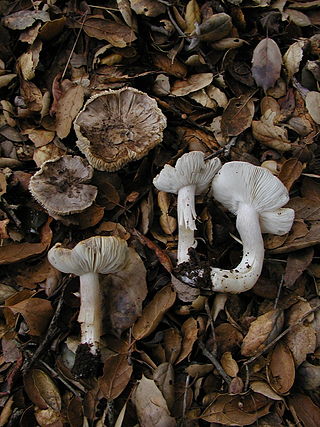
Tricholoma argyraceum is a grey-capped mushroom of the large genus Tricholoma. It has been often confused with the similar-looking Tricholoma scalpturatum.
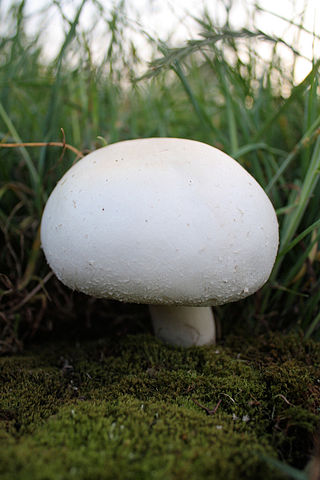
Agaricus arvensis, commonly known as the horse mushroom, is a mushroom-forming fungus of the genus Agaricus.
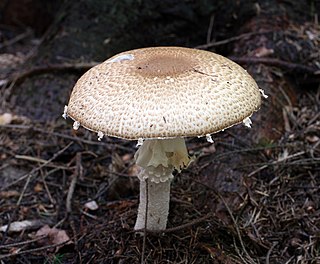
Agaricus augustus, known commonly as the prince, is a basidiomycete fungus of the genus Agaricus.
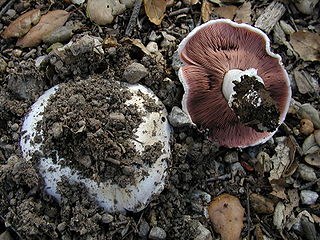
Agaricus bitorquis, commonly known as torq, banded agaric, spring agaric, banded agaricus, urban agaricus, or pavement mushroom, is an edible white mushroom of the genus Agaricus, similar to the common button mushroom that is sold commercially. The name supersedes Agaricus rodmani.

Gymnopilus purpuratus is a species of agaric fungus in the family Hymenogastraceae. It grows in clusters on dead wood, tree stumps and wood chip mulch. It is widely distributed and has been recorded in Argentina, Australia, Chile, New Zealand, the UK and Germany. It has a broadly convex cap covered in small dry reddish-brown scales, a stout yellow stem beneath reddish brown, wine-red to purple vertical fibres, and a thick rusty orange spore print.

Agaricus bernardii, commonly called the salt-loving agaricus, or salty mushroom, is an agaric fungus in the family Agaricaceae. The mushroom's thick stem is usually shorter than the diameter of the cap, which ranges from 5–15 centimetres and is convex to flattened. The cap surface is whitish to buff, and can develop scales or warts in age. The gills are initially pink before turning brown when the spores mature. The flesh turns reddish when it is cut or bruised. It resembles species such as A. bitorquis.

Agaricus dulcidulus is a small mushroom in the family Agaricaceae of the order Agaricales, found in deciduous woodlands of Europe, but also recorded in North America, North Africa and Asia. The English name is rosy wood mushroom. Despite the tendency of some sources to synonymize it with Agaricus semotus, this is a distinct taxon.
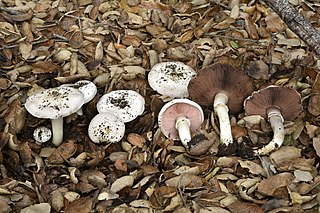
Agaricus californicus, commonly known as the mock meadow mushroom, or California agaricus, is a poisonous mushroom in the section Xanthodermati of the genus Agaricus.

Agaricus silvaticus, otherwise known as the scaly wood mushroom, blushing wood mushroom, or pinewood mushroom, is a species of mushroom often found in groups in coniferous forests from early summer, or September through to November in Europe, North Africa and North America.

Hygrophorus hypothejus, commonly known as the olive-brown waxy cap, or herald of the winter, is an edible species of fungus in the genus Hygrophorus native to Europe. It appears in late autumn in coniferous forests, often with the first frosts.
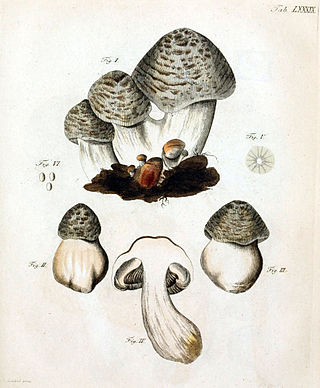
Tricholoma tigrinum is a gilled mushroom. First described under the name Agaricus tigrinus by Jacob Christian Schäffer in 1774, the species was transferred to the genus Tricholoma in 1871 by Paul Kummer.

Agaricus pilatianus (Bohus) is a rare species of poisonous mushroom found in Europe. It is a white to cream colour that discolours when cut, bruised or damaged. The cap can reach sizes of up to 12 centimetres (4.7 in) and can grow to 8 centimetres (3.1 in) in height.
Margit Babos was a Hungarian mycologist born on 28 October 1931 in Budapest. She became one of the most widely recognized mycologists in the second half of the 20th century in Eastern Europe, with contributions to mycological research, fungal taxonomy and recording the mycoflora of Hungary.

Macrolepiota zeyheri is a species of mushroom producing fungus in the family Agaricaceae. In the Kilendu dialect it is known as djilo and in the Kilur dialect it is called n'volo mighom.
Leucocoprinus martinicensis is a species of mushroom producing fungus in the family Agaricaceae.
Gábor Bohus (1914–2005) was a Hungarian mycologist born on 4 July 1914 in Budapest.

















